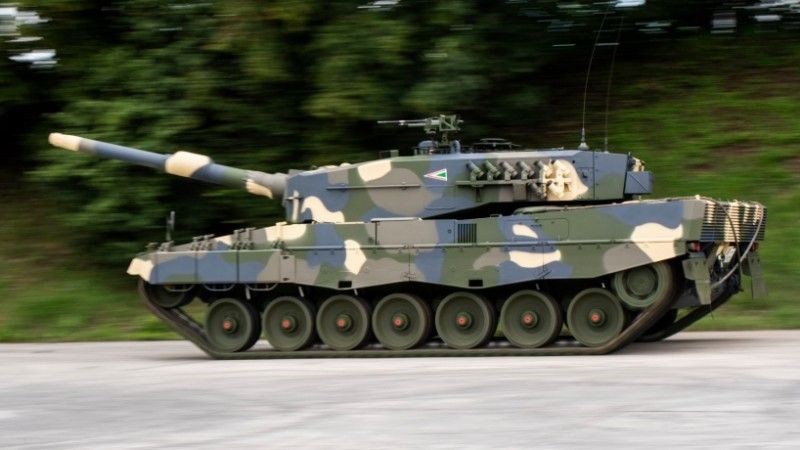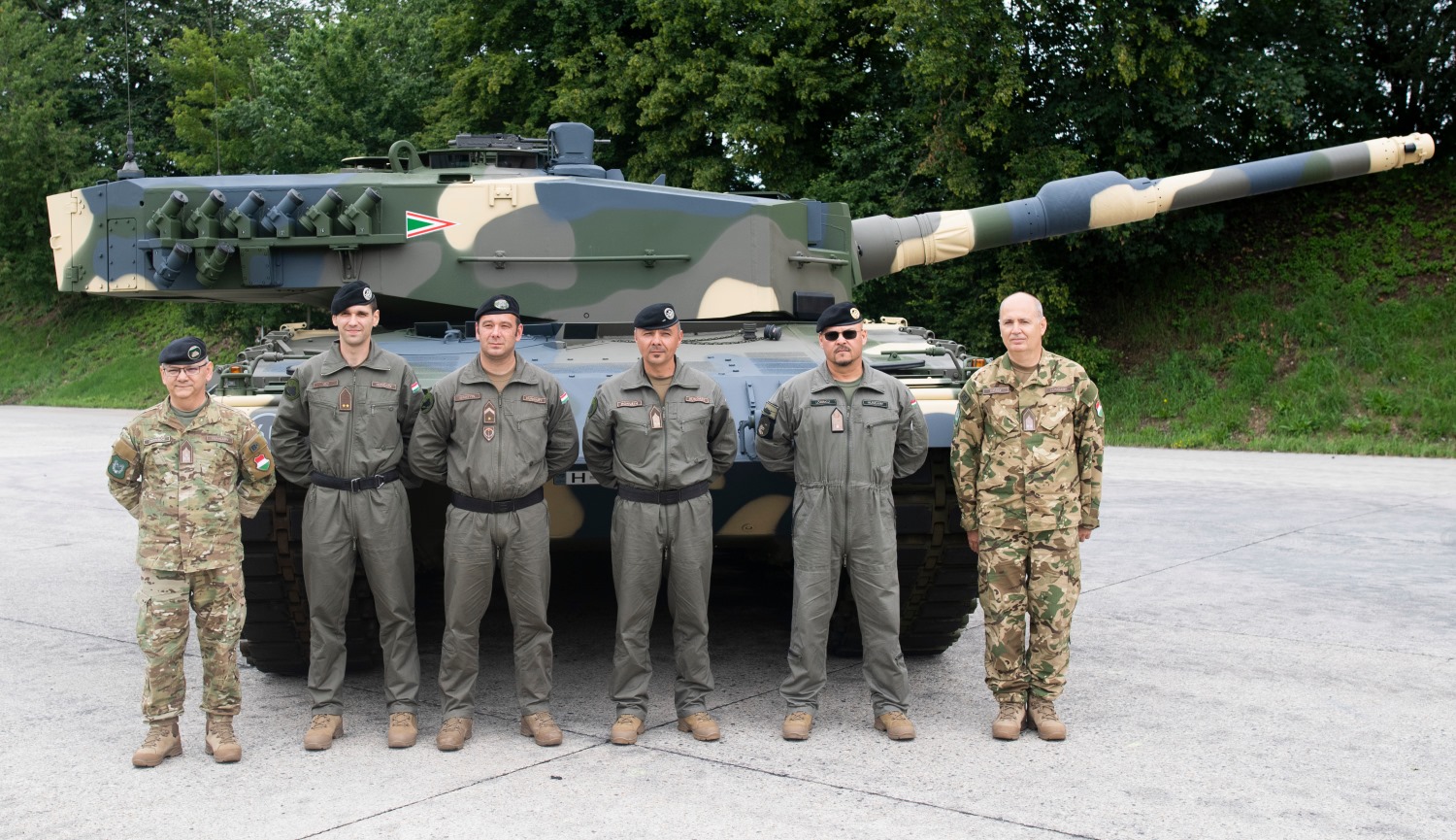Strona główna
Hungarian Leopard MBTs Unveiled. What was the cost? [ANALYSIS]

The first Leopard 2A4 main battle tanks, that are destined to be received by the Hungarian military, have been showcased in Germany. These are a part of an armament and equipment package ordered by Budapest in Germany. The whole bundle also includes new MBTs, howitzers, and support vehicles. Most probably, the cost of the package significantly exceeds 1 billion euros.
Delegates from the Hungarian military just got acquainted with the Leopard 2A4 MBTs that are being readied for delivery at the Krauss-Maffei facility in Munich. The Hungarian military would receive a dozen of vehicles as such soon. They are being reintroduced into active service as they have been stored by KMW. Within the framework of the overhauls, the tanks would also be fitted with new machine guns, replacing the MG3s. The vehicles will be used for training purposes primarily, to train the crews for handling the newer Leopard MBTs - the 2A7+ variant, expected to be delivered to Hungary starting from 2023.
The planned delivery of the Leopard 2A4 MBTs is an introduction for a broader Hungarian armour/artillery modernization programme launched back in 2018. Alongside the Leopard 2A4 main battle tanks acting as a gap-filler, the Hungarians have also ordered 44 brand new Leopard 2A7+ MBTs and 24 PzH 2000 howitzers. The contract also includes delivery of support platforms (such as Wisent 2 ARVs - five vehicles plus extras, or thirteen Rheinmetall HX and TGS heavy-duty logistics support vehicles), along with expansive training and logistics support package.
Delivery of this equipment will make it possible for the Hungarian military to make a generational leap since the Hungarian Army still operates thirty T-72M1 (non-modernized) MBTs and D-20 towed howitzers. This is a part of a broader action plan undertaken within the framework of a strategic modernization programme, also involving procurement of 36 H145M and H225M helicopters from Airbus Helicopters or of the Norwegian NASAMS air defence solution using the AMRAAM and AMRAAM-ER effectors. NASAMS is planned to replace the obsolete Kub SAMs.
Modernization Comes at a Price
The package procured for the Hungarian Army can be viewed as one of the most significant modernization programmes undertaken recently. The procurement also entails significant spending and financial effort. Nonetheless, the value of the deal is not officially known. However, when the deal was being signed, some information emerged suggesting that the cost exceeds EUR 500 million. In practical terms, however, there are many symptoms that the amount is multiple times higher. On the other hand, this could refer to MBTs alone, excluding the howitzers, support measures, and so on.
The German Ministry of Economy and Energy stated that approval has been issued, concerning the arms export to Hungary during the first half of 2019, for an amount of EUR 1.76 bn.. 79.1% of that amount (1.39 bn.) belongs to the A0006 category, including “main battle tanks, self-propelled howitzers, engineering tanks, ARVs, bridges, training tanks”, as well as trucks, ATVs, and parts and extras for the equipment listed above. 103 million euros has been allocated by the Hungarians to procure simulators and associated spares.

It is almost certain that the bulk of the two amounts listed above is associated with the Leopards/howitzers contract. Nonetheless, the 1.76 bn. may also cover other procurements - H145M included. The fact that Leopards and howitzers, along with an expansive package, may cost more than 1 bn euros is also supported by other factors. For instance, back in September 2019, Rheinmetall announced that the company has been awarded a subcontracting agreement for the aforesaid contract, including the delivery of armament and fire control systems for MBTs and SPHs, as well as the support vehicles. Pricetag here was defined as EUR 300 million. Rheinmetall also was awarded an order worth EUR 475 million when KMW had concluded the previous contract, concerning delivery of 62 Leopard 2A7+ MBTs and 24 sphs to Qatar. That very contract had a value of EUR 1.89 bn. This means that Rheinmetall had a share of 25%.
Even though the release issued in 2013 does not list Qatar as the customer, the scope of the deal is almost entirely aligned with what was mentioned when the agreement with Qatar was signed. The release mentions the delivery of “complete L55 tank guns for more than 60 Leopard 2A7 main battle tanks along with fire control electronics and electro-optical sensors for the medium-calibre gun station”. Apart from the above, the agreement also covered the manufacturing of platforms and primary L52 guns for more than 20 PzH 2000 howitzers, along with a driver-training vehicle. The agreement also covered the delivery of ammunition, spares, training, and documentation.
Comparing the scope of contracts signed by Qatar and Hungary, along with the German government’s releases, clearly shows that the agreement signed in 2018 had a value exceeding 1 billion euros. The amount could even be as high as 1.5 billion euro, or even more. This is aligned with the available data on the prices of the brand new equipment. According to one of the reports that have been issued by the German MoD a few years back, a single Leopard 2A7+ MBT has a price tag of EUR 13-15 million. The package procured by the Hungarians is quite expansive, including the equipment for an MBT battalion and artillery squadron, with relevant support assets included.
Procurement done this way entails a high initial cost. However, it may bring some benefits along the life cycle, as no necessity would emerge to procure support vehicles that may cost several million euros apiece, not to mention the simulators or spares. The Hungarian Army is entering the 21st Century dynamically. This has been possible thanks to proper planning and funding of the procurement made.
